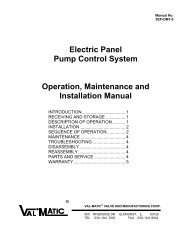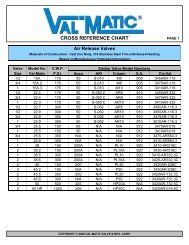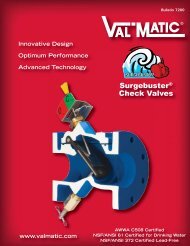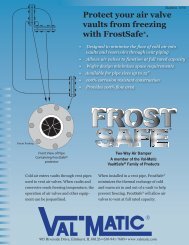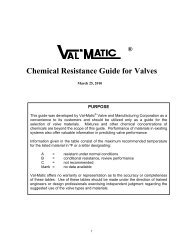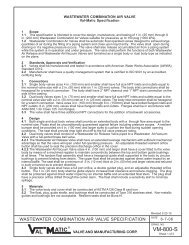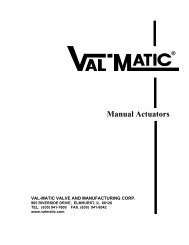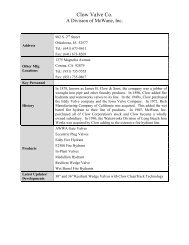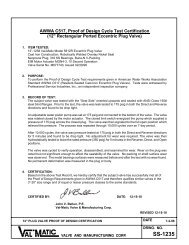CCPV-OM2 - Val-Matic Valve and Manufacturing Corp.
CCPV-OM2 - Val-Matic Valve and Manufacturing Corp.
CCPV-OM2 - Val-Matic Valve and Manufacturing Corp.
Create successful ePaper yourself
Turn your PDF publications into a flip-book with our unique Google optimized e-Paper software.
PACKING REPLACEMENT: To replace the packing(7), it is recommended that the line be drained <strong>and</strong> theactuator removed. The valve can remain in the line. Tereplace the packing, first open the valve <strong>and</strong> drain theline. Close the valve to hold it in position. For poweractuators, turn off <strong>and</strong> lock out electrical <strong>and</strong> hydraulicsupplies before proceeding.CAUTION: Drain line <strong>and</strong> close valve beforeremoving actuator or valve mayrotate suddenly. Take precautionsagainst exposure to toxic orhazardous fluids in the line.Remove the small round cover on actuator to exposeshaft <strong>and</strong> key. Remove actuator mounting bolts <strong>and</strong> liftactuator from valve taking care not to lose square key.See Figure 12 <strong>and</strong> remove gl<strong>and</strong> bolts (19) <strong>and</strong> liftfollower (18) from the valve shaft. Remove old packing(7) with packing hook. Lubricate new packing withFDA grease <strong>and</strong> set in place one ring at a time takingcare not to bend over the lips of the packing rings.Reinstall follower with 2 shims (29) per bolt (3 shimsfor 12” <strong>and</strong> larger valves). With valve in the closedposition, place the actuator over valve <strong>and</strong> reinsert key(24). Finally, reinstall cover on actuator indicating“Closed”.GEAR ACTUATOR MAINTENANCE: A typical gearactuator is shown in Figure 13 <strong>and</strong> consists of a worm(3) mounted on an input shaft (9). The worm engagesa worm wheel (2). When the worm is turned, it drivesthe wheel through 90 of rotation. The rotation of thevalve plug is displayed by the top indicator (5). Theopen <strong>and</strong> closed positions of the segment gear arecontrolled by an end position stop bolts (20). Thestops can be adjusted by loosening the lock nut (21)<strong>and</strong> rotating the bolts. The gears are lubricated withEP2 grease in a cast iron housing (1). Other parts arelisted in Table 5.The gear box is factory lubricated <strong>and</strong> sealed. Noregular maintenance is required. If difficult operation isobserved, the cover (4) can be removed <strong>and</strong> the unitinspected for wear. All moving parts should be coatedwith grease. The grease should have an even <strong>and</strong>smooth consistency. If needed, coat all moving partswith an lithium-based EP-2 grease such as ShellAlvania #2 or equal. Buried units should be packed90% with grease.CAUTION: If packing assembly containsclamp style follower as shown inFigure 8, do not lubricate shaft orsleeve.PACKING REPLACEMENT WITH ACTUATOR: Theabove procedure with removal of the actuator will resultin the most reliable shaft seal. But if the actuator cannot be removed, the following alternate procedure canbe followed. To prevent the possibility of leakageduring this procedure, open valve <strong>and</strong> drain the line.CAUTION: Take precautions againstexposure to toxic or hazardousfluids in the line.Referring to Figure 12, remove follower bolts (19) <strong>and</strong>side follower (18) up to actuator. Remove packingadapters <strong>and</strong> rings (7) with packing hook. Cut ringswith knife to remove. New packing rings should be cutat a 45 degree slope to allow insertion around the shaft<strong>and</strong> provide some overlap. Install rings one at a timewith the tips down toward the valve. Stagger all joints180 degrees around the shaft. Pull down follower (18)<strong>and</strong> reinsert bolts (19) with 2 shims (29) under follower(18). V-packing is pressure assisted <strong>and</strong> only requireslight compression.FIGURE 13. GEAR ACTUATOR CONSTRUCTION8



